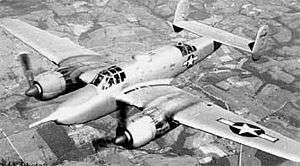Beechcraft XA-38 Grizzly
| XA-38 Grizzly | |
|---|---|
 | |
| Role | Ground attack |
| National origin | United States |
| Manufacturer | Beechcraft |
| First flight | 7 May 1944 |
| Status | Canceled |
| Primary user | United States Army Air Forces |
| Number built | Two |
|
| |
The Beechcraft XA-38 Grizzly was a World War II-era ground attack aircraft, developed by Beechcraft, but never put into production. The Grizzly was to have been fitted with a forward-firing 75 mm cannon, to penetrate heavily-armored targets.
While the first prototype flew on 7 May 1944, testing established that the type would not be ready for the projected invasion of Japan. It also featured the Wright R-3350 engines already in use with the Boeing B-29 Superfortress — which had priority. Consequently the XA-38 was canceled after a second prototype had been completed.
Design and development
The United States Army Air Forces awarded the Beech Aircraft Corporation a contract in December 1942 for two prototypes for their Model 28 "Destroyer". The requirement was for a powerful ground attack aircraft to replace the Douglas A-20 Havoc, with the ability to hit "hardened" targets like tanks and bunkers. This capability was achieved through a 75 mm cannon with 20 rounds, mounted in a fixed position on the nose as well as two .50 cal (12.7 mm) M2 Browning machine guns firing forward. Defensive armament consisted of remotely controlled ventral and dorsal turrets, each armed with twin .50 cal (12.7 mm) machine guns. There were to be two crew members, a pilot and an observer/gunner in the rear cabin, using periscope sights to aim the guns.
Testing
On 7 May 1944, Beech test pilot Vern Carstens flew the XA-38 on its maiden flight from the company's Wichita airfield. The aircraft proved satisfactory in all respects and better than expected in some, including top speed.
During testing, the XA-38 prototypes were flown by U.S. Army pilots and serviced by military personnel, proving to be reliable and establishing a high level of serviceability.[1]
The armament proved especially effective and had it not been for wartime priorities shifting in 1944, the aircraft would most likely have been ordered in quantity, although the B-29 had priority for the Wright R-3350 engines. Instead, one prototype was scrapped and the other, intended for the USAF Museum, had an unknown fate.
Specifications
Data from Plane Facts: The big gun Beech[2]
General characteristics
- Crew: 2
- Length: 51 ft 9 in (15.77 m)
- Wingspan: 67 ft 4 in (20.52 m)
- Height: 15 ft 6 in (4.72 m)
- Wing area: 626 ft² (58.15 m²)
- Empty weight: 22,480 lb (10,197 kg)
- Max. takeoff weight: 35,265 lb (15,996 kg)
- Powerplant: 2 × Wright R-3350-43 air-cooled radial engine, 2,300 hp (1,716 kW) each
Performance
- Maximum speed: 370 mph (322 knots, 595 km/h) at 17,000 ft (5,180 m)
- Range: 1,625 miles (1,413 nmi, 2,615 km)
- Service ceiling: 29,000 ft (8,840 m)
- Rate of climb: 2,600 ft/min (13.2 m/s)
Armament
- Guns:
- 1 × T15E1 75 mm cannon (20 rounds)
- 6 × 50 caliber (12.7 mm) M2 Browning machine guns (2 forward-facing, 2 in ventral turret, 2 in dorsal turret)
See also
- Aircraft of comparable role, configuration and era
- Related lists
References
- Notes
- Bibliography
- McCullough, Anson. "Grind 'Em Out Ground Attack: The Search for the Elusive Fighter Bomber". Wings Vol. 25, No. 4, August 1995.
- "Plane Facts: The big gun Beech". Air International, Vol 30 No 6, June 1986, p. 300. ISSN 0306-5634.
- Trimble, Robert L. "Beech Grizzly". Air Classics Vol. 9, no. 7, August 1983.
External links
| Wikimedia Commons has media related to Beechcraft XA-38 Grizzly. |